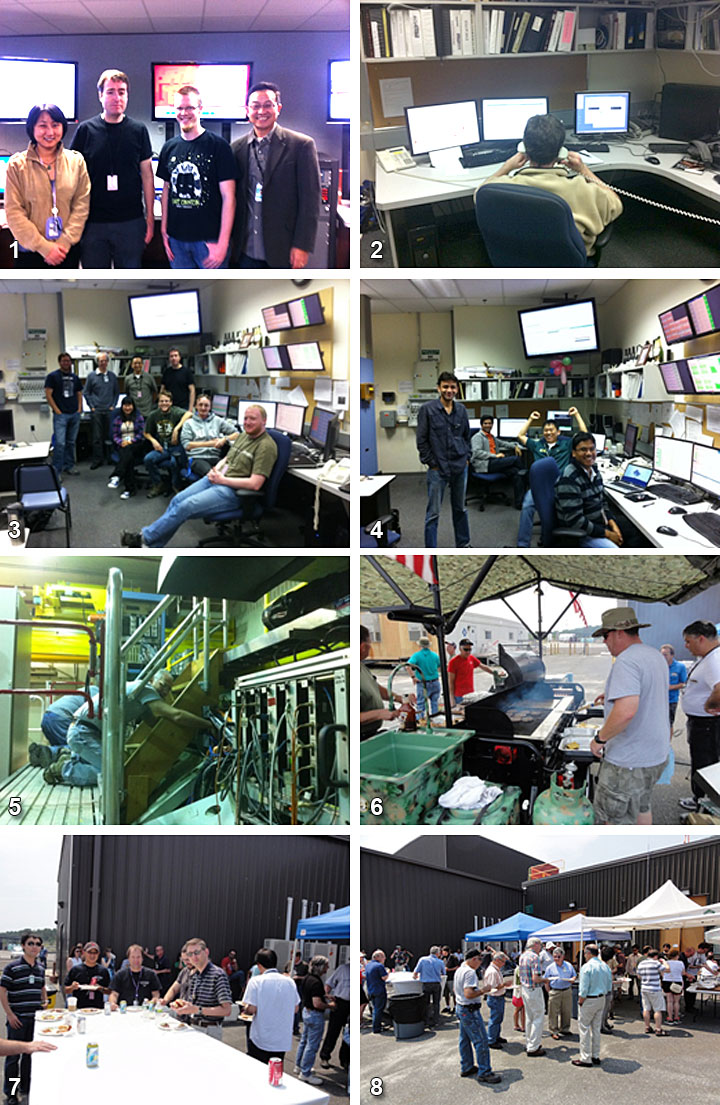PHENIX — Inside Run-12
January 15, 2013
By Xiaochun He
Shortly after the midnight of June 28, 2012, I walked out of the PHENIX counting house and made sure that the last PHENIX shift crew for Run-12 safely exited the PHENIX site and the doors were securely locked. To me, this marked as the official ending point of a superb PHENIX operation in RHIC Run-12.
This PHENIX story should have been told earlier since both RHIC and PHENIX are about to be ready for another run – Run-13. To be honest, writing this story was not on my to-do-list after spending many sleepless nights at BNL for six months since the mid of January of 2012. Let me start the story with a brief timeline of the run.
The RHIC Run-12 physics run started with 200 GeV transversely polarized proton+proton collisions. PHENIX collected 4.5 billion events during a period of four and a half weeks, which was ended on March 12, 2012.
After a short one half-week setup, RHIC was successfully running longitudinally polarized proton+proton collisions at 510 GeV. This running period lasted for five weeks and ended on April 19, 2012. PHENIX successfully reached the goal of sampling a total integrated luminosity of 30 pb-1 for the W-physics program and demonstrated a viable RHIC spin program.
The RHIC Run-12 heavy ion run began with running uranium+uranium (U+U) collisions at a center of mass energy of 193 GeV per pair of colliding nucleons, the heaviest colliding system ever accelerated at RHIC to date. The setup took barely one-week period and the physics run was declared on April 25. The non-spherical shape of the uranium nucleus allows heavy ion physicists to explore the geometry dependent properties of heavy ion collisions. This run period ended on May 15. PHENIX collected over 3 billion events and took 50% more data than the projected goal.
The magic of RHIC Run-12 operation continued. In three days after the end of the U+U run, RHIC reached to another historical milestone by colliding copper and gold nuclei (Cu+Au) at 200 GeV energy per nucleon pair, a top heavy ion physics priority of PHENIX for Run-12. The Cu+Au run lasted for about 5.5 weeks and was ended on June 25, which allowed PHENIX for collecting about 9.8 billion events.
The RHIC Run-12 operation has been a spectacular success. The scientific achievements have been presented at the RHIC/AGS Users' Meeting, at the RHIC Run-12 Retreat, and at the Quark Matter 2012 conference held in late August of 2012 in Washington DC. This success was resulted from a well-defined run schedule (led by Dr. Steve Vigdor), a talented group of C-AD run coordinators (Vincent Schoefer, Yun Luo and Christoph Montag) and the entire C-AD team.
The unique capability of the RHIC facility and its strength in flexibility for exploring QCD matter properties in heavy ion collisions and for resolving proton spin puzzle have been historically demonstrated in Run-12 for a period of six-month operation.
The PHENIX success came from all fronts in operation. While it is impossible to list names who played significant roles in Run-12, it is appropriate to name a few individuals and groups in PHENIX that I had to rely on pretty much daily for running the experiment.
PHENIX management led by Ed Obrien; PHENIX tech team led by Don Lynch; PHENIX counting house residents (John Haggerty, Martin Purschke, Chris Pinkenburg and Ed Desmond); PHENIX Run-12 Spin Coordinator (John Koster); the group of thirteen Period Coordinators; the FVTX detector commissioning team and so on.
There were a few moments in Run-12 we were pulling our hair off trying to get the experiment running and/or anxiously waiting for beams. Sometimes we had to yield to the force of nature, whether it was a lightning strike or an eagle landing or something else. Quite a few of these episodes were reported at the weekly Time Meeting during the run. At the end, all of these dramatic events amplified the joy we all had in Run-12.
To end this short story, I would like to share a few pictures I collected over the course of Run-12.
(1) Mei Bai, John Koster, Vincent Schoefer and Xiaochun He in MCR. (2)John Koster was communicating with subsystem experts (two) in order to keep the experiment running. (3) Shift crew post after reaching the physics goal of 510 GeV pp run. (4) Happy owl shift crew after reaching the physics goal for Cu+Au run. (5) PHENIX tech team working on detector electronics. (6) PHENIX tech team preparing food for the PHENIX end-of-run party. (7) PHENIX end-of-run party. (8) PHENIX end-of-run party.
2013-3619 | INT/EXT | Newsroom









